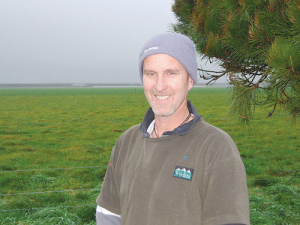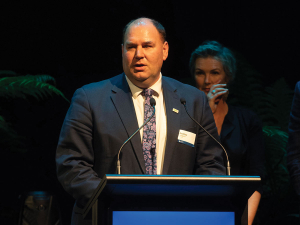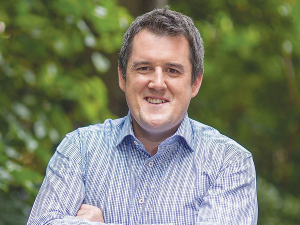Coltman has already reduced leaching while increasing production, and believes he can keep cutting nitrogen leaching and meet the targets, hopefully without having to de-stock.
The aim is efficiency, he says.
The recent South Island Dairy Event (SIDE) conference heard a paper subtitled “Reducing N Leaching in Real Life”, which modelled two different methods of meeting the 2022 standards, using Coltman’s Canlac Holdings farm at Dunsandel as the guinea pig.
The paper said several New Zealand catchments must reduce agricultural nutrient loss to improve water quality. Dairy milking platforms in the Selwyn/Te Waihora catchment – including Canlac -- have to cut N losses by 30% below their 2009-2013 baseline good management practice rate. In Canlac’s case, the baseline was 71kg N/ha/yr so the 2022 target is 50kg N/ha/yr.
The models showed loading reduced by cutting cow numbers: the first modelled reduced numbers in autumn by early culling of non-pregnant cows; the second modelled a year-round cut of 50 cows while maintaining the current culling strategy. Both scenarios also called for cuts in nitrogen fertiliser and irrigation applications, and a lower proportion of high-protein feeds in imported supplements.
The early-culling scenario met the nitrogen loss target, at 49kg N/ha, but the scenario with fewer stock year-round did not, coming in at 53kg N/ha. Both showed about 5% lower farm income.
While the study used Coltman’s farm for the modelling, and he is credited as co-author of the paper with DairyNZ scientists and others, he does not see destocking or the loss of income as inevitable.
Coltman says his farm was already down to an estimated 57kg/ha/yr in the immediate past season, so only needs to reduce leaching by another 6-7kg/ha to meet the target.
“My personal view is that there are mitigations and other things you can do, so we haven’t reduced stocking rate. When we get all those in place let’s see where we sit then we can look at what we can do on stocking rates.”
Coltman agrees Canterbury may have reached “peak cow” but says people don’t realise what they can do with the numbers they have.
It is also sending the wrong message to focus on the possible income loss. “It’s not going to make us broke,” he says.
Canlac is 335ha effective and milked 1390 cows at peak in the 2015-16 season. In just their fourth season on the farm, Coltman and his partner Dana Carver produced 719,000kgMS, up 140,000 on the previous yearly average of 580,000. Yield per hectare has gone from 1700 – 2150kgMS.
Coltman says the farm has installed another pivot – half had been under Roto-Rainers -- and doubled the area of effluent spread. They reduced the amount of nitrogen fertiliser applied by 50kg/ha (applying at the same frequency but less each time) while harvesting the same amount of grass.
Further reductions came from installing a feed pad and changing the feeding mix. Lower-protein feeds like maize and fodder beet are fed on the pad, in spring to reduce weight loss after calving, and in autumn to improve weight gain before drying off. Coltman says the pad reduces waste and pasture damage, and the lower-protein mix also means less nitrogen being imported.
The pad has one disadvantage, according to the nitrogen modelling, in that it increases the amount of effluent collected and so counts as a detrimental increase in the effluent load.
“I think the model’s wrong, because if you’ve got plenty of storage then we just pump it when the conditions are right to pump it,” says Coltman. “To me it’s better we collect it and put it out when it’s more efficiently taken up by the plants.”
He says improving environmental footprint requires efficiency of resources – “efficient use of nitrogen, efficient use of feed, efficient use of irrigation -- the whole lot. Do that first then look at whether you have to reduce your stocking rate. Change your types of feeds if you can. That’s the way I look at it.”
Other farmers might decide it’s easier to keep their systems unchanged and just reduce the number of cows. However, he believes it can be harder to manage a low-stocked farm. It can make it more difficult to control periods of high grass growth and meet high fixed costs such as irrigation.
In the paper presented to the SIDE conference, both reduction scenarios recorded improved nitrogen conversion efficiency, reflecting the reduced amount of N brought onto the farm: the N surplus was reduced by 11-13% and the N conversion efficiency was improved by 3%.
The paper said both scenarios also showed big gains in ‘eco-efficiency’ -- a measure of how much is produced per unit of environmental impact. Measured in kg of milk solids produced per kg of nitrogen surplus, eco-efficiency increased by 64-69%; measured in dollars of operating profit achieved per kg of nitrogen surplus, it increased by 61-67%.
Meanwhile, Canlac is one of several farms taking part in the large Forages for Reduced Nitrate Leaching (FRNL) research project, which aims to find pasture plants and forage crops that help reduce leaching by reducing the surplus N intake of animals, reducing or altering urinary N excretion and increasing plant N uptake from the soil.
Coltman says he joined the study because it was not an area of strength for him. “I thought, rather than stand outside and throw stones let’s get involved and get some real numbers.”
He has now planted low-nitrogen plantain on about 10% of the farm and will increase that as paddocks are re-grassed.









